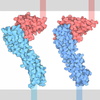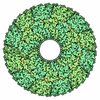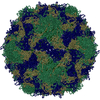+ データを開く
データを開く
- 基本情報
基本情報
| 登録情報 | データベース: PDB / ID: 3j8f | |||||||||
|---|---|---|---|---|---|---|---|---|---|---|
| タイトル | Cryo-EM reconstruction of poliovirus-receptor complex | |||||||||
 要素 要素 |
| |||||||||
 キーワード キーワード | VIRUS/SIGNALING PROTEIN / poliovirus / receptor / PVR / CD155 / VIRUS-SIGNALING PROTEIN complex | |||||||||
| 機能・相同性 |  機能・相同性情報 機能・相同性情報susceptibility to T cell mediated cytotoxicity / susceptibility to natural killer cell mediated cytotoxicity / Nectin/Necl trans heterodimerization / positive regulation of natural killer cell mediated cytotoxicity directed against tumor cell target / symbiont-mediated suppression of host translation initiation / positive regulation of natural killer cell mediated cytotoxicity / negative regulation of natural killer cell mediated cytotoxicity / heterophilic cell-cell adhesion via plasma membrane cell adhesion molecules / natural killer cell mediated cytotoxicity / homophilic cell adhesion via plasma membrane adhesion molecules ...susceptibility to T cell mediated cytotoxicity / susceptibility to natural killer cell mediated cytotoxicity / Nectin/Necl trans heterodimerization / positive regulation of natural killer cell mediated cytotoxicity directed against tumor cell target / symbiont-mediated suppression of host translation initiation / positive regulation of natural killer cell mediated cytotoxicity / negative regulation of natural killer cell mediated cytotoxicity / heterophilic cell-cell adhesion via plasma membrane cell adhesion molecules / natural killer cell mediated cytotoxicity / homophilic cell adhesion via plasma membrane adhesion molecules / symbiont-mediated suppression of host cytoplasmic pattern recognition receptor signaling pathway via inhibition of RIG-I activity / cell adhesion molecule binding / symbiont-mediated suppression of host cytoplasmic pattern recognition receptor signaling pathway via inhibition of MDA-5 activity / symbiont-mediated suppression of host cytoplasmic pattern recognition receptor signaling pathway via inhibition of MAVS activity / ribonucleoside triphosphate phosphatase activity / adherens junction / picornain 2A / symbiont-mediated suppression of host mRNA export from nucleus / symbiont genome entry into host cell via pore formation in plasma membrane / picornain 3C / T=pseudo3 icosahedral viral capsid / host cell cytoplasmic vesicle membrane / Immunoregulatory interactions between a Lymphoid and a non-Lymphoid cell / signaling receptor activity / nucleoside-triphosphate phosphatase / virus receptor activity / channel activity / monoatomic ion transmembrane transport / RNA helicase activity / receptor ligand activity / endocytosis involved in viral entry into host cell / symbiont-mediated activation of host autophagy / RNA-directed RNA polymerase / cysteine-type endopeptidase activity / viral RNA genome replication / focal adhesion / RNA-directed RNA polymerase activity / DNA-templated transcription / virion attachment to host cell / host cell nucleus / structural molecule activity / cell surface / proteolysis / extracellular space / RNA binding / zinc ion binding / ATP binding / membrane / plasma membrane / cytoplasm 類似検索 - 分子機能 | |||||||||
| 生物種 |  Homo sapiens (ヒト) Homo sapiens (ヒト)  Human poliovirus 1 Mahoney (ポリオウイルス) Human poliovirus 1 Mahoney (ポリオウイルス) | |||||||||
| 手法 | 電子顕微鏡法 / 単粒子再構成法 / クライオ電子顕微鏡法 / 解像度: 4 Å | |||||||||
 データ登録者 データ登録者 | Strauss, M. / Filman, D.J. / Belnap, D.M. / Cheng, N. / Noel, R.T. / Hogle, J.M. | |||||||||
 引用 引用 |  ジャーナル: J Virol / 年: 2015 ジャーナル: J Virol / 年: 2015タイトル: Nectin-like interactions between poliovirus and its receptor trigger conformational changes associated with cell entry. 著者: Mike Strauss / David J Filman / David M Belnap / Naiqian Cheng / Roane T Noel / James M Hogle /  要旨: Poliovirus infection is initiated by attachment to a receptor on the cell surface called Pvr or CD155. At physiological temperatures, the receptor catalyzes an irreversible expansion of the virus to ...Poliovirus infection is initiated by attachment to a receptor on the cell surface called Pvr or CD155. At physiological temperatures, the receptor catalyzes an irreversible expansion of the virus to form an expanded form of the capsid called the 135S particle. This expansion results in the externalization of the myristoylated capsid protein VP4 and the N-terminal extension of the capsid protein VP1, both of which become inserted into the cell membrane. Structures of the expanded forms of poliovirus and of several related viruses have recently been reported. However, until now, it has been unclear how receptor binding triggers viral expansion at physiological temperature. Here, we report poliovirus in complex with an enzymatically partially deglycosylated form of the 3-domain ectodomain of Pvr at a 4-Å resolution, as determined by cryo-electron microscopy. The interaction of the receptor with the virus in this structure is reminiscent of the interactions of Pvr with its natural ligands. At a low temperature, the receptor induces very few changes in the structure of the virus, with the largest changes occurring within the footprint of the receptor, and in a loop of the internal protein VP4. Changes in the vicinity of the receptor include the displacement of a natural lipid ligand (called "pocket factor"), demonstrating that the loss of this ligand, alone, is not sufficient to induce particle expansion. Finally, analogies with naturally occurring ligand binding in the nectin family suggest which specific structural rearrangements in the virus-receptor complex could help to trigger the irreversible expansion of the capsid. IMPORTANCE: The cell-surface receptor (Pvr) catalyzes a large structural change in the virus that exposes membrane-binding protein chains. We fitted known atomic models of the virus and Pvr into ...IMPORTANCE: The cell-surface receptor (Pvr) catalyzes a large structural change in the virus that exposes membrane-binding protein chains. We fitted known atomic models of the virus and Pvr into three-dimensional experimental maps of the receptor-virus complex. The molecular interactions we see between poliovirus and its receptor are reminiscent of the nectin family, by involving the burying of otherwise-exposed hydrophobic groups. Importantly, poliovirus expansion is regulated by the binding of a lipid molecule within the viral capsid. We show that receptor binding either causes this molecule to be expelled or requires it, but that its loss is not sufficient to trigger irreversible expansion. Based on our model, we propose testable hypotheses to explain how the viral shell becomes destabilized, leading to RNA uncoating. These findings give us a better understanding of how poliovirus has evolved to exploit a natural process of its host to penetrate the membrane barrier. | |||||||||
| 履歴 |
|
- 構造の表示
構造の表示
| ムービー |
 ムービービューア ムービービューア |
|---|---|
| 構造ビューア | 分子:  Molmil Molmil Jmol/JSmol Jmol/JSmol |
- ダウンロードとリンク
ダウンロードとリンク
- ダウンロード
ダウンロード
| PDBx/mmCIF形式 |  3j8f.cif.gz 3j8f.cif.gz | 218.7 KB | 表示 |  PDBx/mmCIF形式 PDBx/mmCIF形式 |
|---|---|---|---|---|
| PDB形式 |  pdb3j8f.ent.gz pdb3j8f.ent.gz | 168.3 KB | 表示 |  PDB形式 PDB形式 |
| PDBx/mmJSON形式 |  3j8f.json.gz 3j8f.json.gz | ツリー表示 |  PDBx/mmJSON形式 PDBx/mmJSON形式 | |
| その他 |  その他のダウンロード その他のダウンロード |
-検証レポート
| アーカイブディレクトリ |  https://data.pdbj.org/pub/pdb/validation_reports/j8/3j8f https://data.pdbj.org/pub/pdb/validation_reports/j8/3j8f ftp://data.pdbj.org/pub/pdb/validation_reports/j8/3j8f ftp://data.pdbj.org/pub/pdb/validation_reports/j8/3j8f | HTTPS FTP |
|---|
-関連構造データ
- リンク
リンク
- 集合体
集合体
| 登録構造単位 | 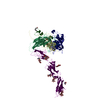
|
|---|---|
| 1 | x 60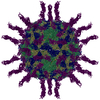
|
| 2 |
|
| 3 | x 5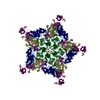
|
| 4 | x 6
|
| 5 | 
|
| 対称性 | 点対称性: (シェーンフリース記号: I (正20面体型対称)) |
- 要素
要素
-Capsid protein ... , 4種, 4分子 1234
| #1: タンパク質 | 分子量: 33488.613 Da / 分子数: 1 / 断片: UNP residues 580-881 / 由来タイプ: 天然 由来: (天然)   Human poliovirus 1 Mahoney (ポリオウイルス) Human poliovirus 1 Mahoney (ポリオウイルス)参照: UniProt: P03300 |
|---|---|
| #2: タンパク質 | 分子量: 30075.783 Da / 分子数: 1 / 断片: UNP residues 70-341 / 由来タイプ: 天然 由来: (天然)   Human poliovirus 1 Mahoney (ポリオウイルス) Human poliovirus 1 Mahoney (ポリオウイルス)参照: UniProt: P03300 |
| #3: タンパク質 | 分子量: 26547.482 Da / 分子数: 1 / 断片: UNP residues 342-579 / 由来タイプ: 天然 由来: (天然)   Human poliovirus 1 Mahoney (ポリオウイルス) Human poliovirus 1 Mahoney (ポリオウイルス)参照: UniProt: P03300 |
| #4: タンパク質 | 分子量: 7603.405 Da / 分子数: 1 / 断片: UNP residues 2-69 / 由来タイプ: 天然 由来: (天然)   Human poliovirus 1 Mahoney (ポリオウイルス) Human poliovirus 1 Mahoney (ポリオウイルス)参照: UniProt: P03300 |
-タンパク質 , 1種, 1分子 7
| #5: タンパク質 | 分子量: 46168.215 Da / 分子数: 1 / 由来タイプ: 組換発現 / 由来: (組換発現)  Homo sapiens (ヒト) / 遺伝子: PVR, PVS / 発現宿主: Homo sapiens (ヒト) / 遺伝子: PVR, PVS / 発現宿主:  |
|---|
-糖 , 5種, 7分子 
| #6: 多糖 | | #7: 多糖 | beta-D-mannopyranose-(1-3)-beta-D-mannopyranose-(1-4)-2-acetamido-2-deoxy-beta-D-glucopyranose-(1-4) ...beta-D-mannopyranose-(1-3)-beta-D-mannopyranose-(1-4)-2-acetamido-2-deoxy-beta-D-glucopyranose-(1-4)-[alpha-L-fucopyranose-(1-6)]2-acetamido-2-deoxy-beta-D-glucopyranose | #8: 多糖 | #9: 多糖 | beta-D-mannopyranose-(1-4)-2-acetamido-2-deoxy-beta-D-glucopyranose-(1-4)-[alpha-L-fucopyranose-(1- ...beta-D-mannopyranose-(1-4)-2-acetamido-2-deoxy-beta-D-glucopyranose-(1-4)-[alpha-L-fucopyranose-(1-6)]2-acetamido-2-deoxy-beta-D-glucopyranose | #10: 糖 | ChemComp-NAG / | |
|---|
-実験情報
-実験
| 実験 | 手法: 電子顕微鏡法 |
|---|---|
| EM実験 | 試料の集合状態: PARTICLE / 3次元再構成法: 単粒子再構成法 |
- 試料調製
試料調製
| 構成要素 |
| ||||||||||||||||||||
|---|---|---|---|---|---|---|---|---|---|---|---|---|---|---|---|---|---|---|---|---|---|
| 分子量 | 値: 12 MDa / 実験値: NO | ||||||||||||||||||||
| ウイルスについての詳細 | 中空か: NO / エンベロープを持つか: NO / ホストのカテゴリ: VERTEBRATES / 単離: STRAIN / タイプ: VIRION | ||||||||||||||||||||
| 天然宿主 | 生物種: Homo sapiens | ||||||||||||||||||||
| 緩衝液 | 名称: PBS / pH: 7 / 詳細: PBS | ||||||||||||||||||||
| 試料 | 濃度: 1 mg/ml / 包埋: NO / シャドウイング: NO / 染色: NO / 凍結: YES | ||||||||||||||||||||
| 試料支持 | 詳細: 200 mesh Cu grid with fenestrated carbon support | ||||||||||||||||||||
| 急速凍結 | 装置: HOMEMADE PLUNGER / 凍結剤: ETHANE / Temp: 120 K / 湿度: 45 % 詳細: Sample mixed and frozen within 2 minutes before plunging into liquid ethane. 手法: Sample mixed and frozen within 2 minutes. |
- 電子顕微鏡撮影
電子顕微鏡撮影
| 実験機器 |  モデル: Tecnai Polara / 画像提供: FEI Company |
|---|---|
| 顕微鏡 | モデル: FEI POLARA 300 / 日付: 2013年11月1日 / 詳細: K2 Summit super-resolution mode used |
| 電子銃 | 電子線源:  FIELD EMISSION GUN / 加速電圧: 300 kV / 照射モード: FLOOD BEAM FIELD EMISSION GUN / 加速電圧: 300 kV / 照射モード: FLOOD BEAM |
| 電子レンズ | モード: BRIGHT FIELD / 倍率(公称値): 27500 X / 倍率(補正後): 25355 X / 最大 デフォーカス(公称値): 3000 nm / 最小 デフォーカス(公称値): 1000 nm / Cs: 2.26 mm |
| 試料ホルダ | 試料ホルダーモデル: OTHER / 資料ホルダタイプ: Polara / 温度: 100 K / 最高温度: 165 K / 最低温度: 80 K |
| 撮影 | 電子線照射量: 25 e/Å2 / フィルム・検出器のモデル: GATAN K2 (4k x 4k) |
| 画像スキャン | デジタル画像の数: 285 |
| 放射 | プロトコル: SINGLE WAVELENGTH / 単色(M)・ラウエ(L): M / 散乱光タイプ: x-ray |
| 放射波長 | 相対比: 1 |
- 解析
解析
| ソフトウェア | 名称: REFMAC / バージョン: 5.8.0073 / 分類: 精密化 | |||||||||||||||||||||||||||||||||||||||||||||
|---|---|---|---|---|---|---|---|---|---|---|---|---|---|---|---|---|---|---|---|---|---|---|---|---|---|---|---|---|---|---|---|---|---|---|---|---|---|---|---|---|---|---|---|---|---|---|
| EMソフトウェア |
| |||||||||||||||||||||||||||||||||||||||||||||
| CTF補正 | 詳細: per micrograph | |||||||||||||||||||||||||||||||||||||||||||||
| 対称性 | 点対称性: I (正20面体型対称) | |||||||||||||||||||||||||||||||||||||||||||||
| 3次元再構成 | 解像度: 4 Å / 解像度の算出法: FSC 0.143 CUT-OFF / 粒子像の数: 9248 / ピクセルサイズ(公称値): 0.964 Å / ピクセルサイズ(実測値): 0.964 Å / 詳細: (Single particle--Applied symmetry: I) / 対称性のタイプ: POINT | |||||||||||||||||||||||||||||||||||||||||||||
| 原子モデル構築 | プロトコル: FLEXIBLE FIT / 空間: RECIPROCAL / Target criteria: pseudo-real space 詳細: REFINEMENT PROTOCOL--flexible DETAILS--After rigid-body fitting, manual rebuilding of the model was alternated with automated stereochemically restrained refinement, minimizing the ...詳細: REFINEMENT PROTOCOL--flexible DETAILS--After rigid-body fitting, manual rebuilding of the model was alternated with automated stereochemically restrained refinement, minimizing the discrepancy between the experimental and model-based Fourier amplitudes and phases. | |||||||||||||||||||||||||||||||||||||||||||||
| 原子モデル構築 |
| |||||||||||||||||||||||||||||||||||||||||||||
| 精密化 | 解像度: 3.7→98.92 Å / Cor.coef. Fo:Fc: 0.702 / SU B: 39.671 / SU ML: 0.607 / σ(F): 0 / ESU R: 0.558 立体化学のターゲット値: MAXIMUM LIKELIHOOD WITH PHASES
| |||||||||||||||||||||||||||||||||||||||||||||
| 原子変位パラメータ | Biso max: 300 Å2 / Biso mean: 45.098 Å2 / Biso min: 10 Å2
| |||||||||||||||||||||||||||||||||||||||||||||
| 精密化ステップ | サイクル: LAST / 解像度: 3.7→98.92 Å
| |||||||||||||||||||||||||||||||||||||||||||||
| 拘束条件 |
| |||||||||||||||||||||||||||||||||||||||||||||
| LS精密化 シェル | 解像度: 3.7→3.9 Å / Total num. of bins used: 10 /
|
 ムービー
ムービー コントローラー
コントローラー














 PDBj
PDBj
